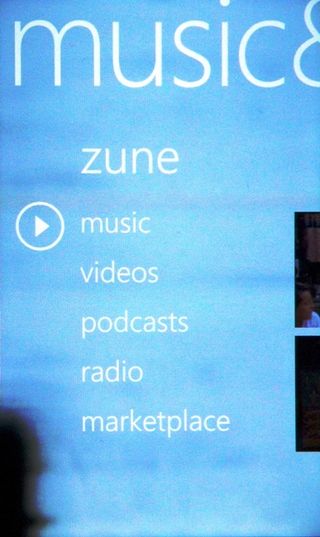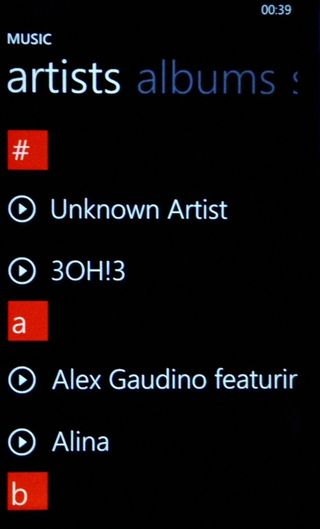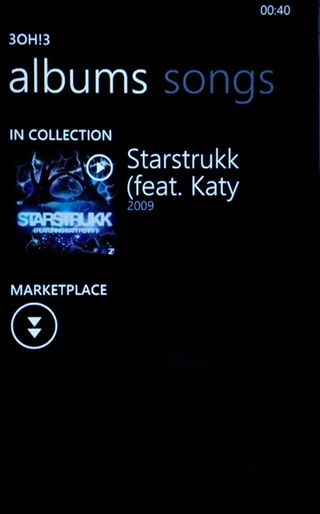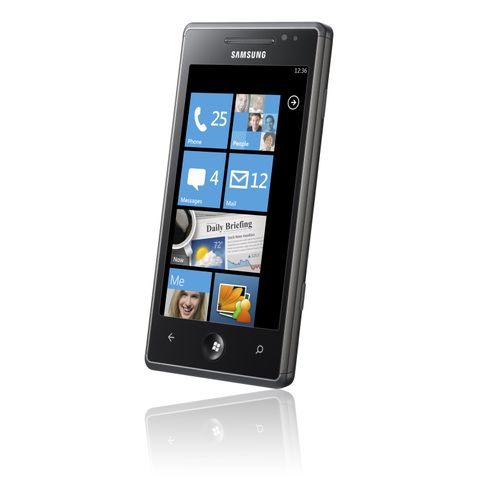Why you can trust TechRadar
The Samsung Omnia 7 uses the Zune interface to work on the media side of things, meaning the only way to get information on and off the phone is through the Zune software.
This is a little bit of a chore, because we prefer to drag and drop files onto our phone, but sadly that's not an option here – once again showing how Microsoft wants to lock down the experience.
However, the Zune software on the Omnia 7 is just top notch, so that really helps make up for the problems. We like the way we get shown our history of tracks or videos just played, and swiping left and right to get to separate areas feels intuitive.

Sound output through headphones is good, if not stellar – the lack of audio tweaking on offer means that some songs seem flat where on other Windows Phone 7 devices with said audio boosting on offer (the HTC HD7, for instance) you can really make a sonic difference by having a little fiddle.
The list of audio you can connect to is adequately comprehensive, and as mentioned the Zune interface is a really nice way of navigating around. The most recently played and history items are all offered up as icons, and the background of the Zune media experience automatically changes to the artist you last listened to on the Zune marketplace.

Being in the UK, we've been a little bit hard done by when it comes to the Zune Pass, which had the potential to be a real game changer for the way we consume music on our mobiles.
Positioned somewhere between Nokia's Ovi Music Unlimited and Spotify for Mobile, Zune Pass offers free streaming of a ridiculous amount of tracks from the marketplace, and then 10 to keep DRM free.
Except that's only for the US, despite that territory's Pass costing the same amount as in the UK (around £26 for three months' use) and we're waiting to hear back from Microsoft on why this is.
Zune Pass also only enables you to stream songs from an album in sequence, not allowing the creation of playlists, so it's not the stellar service it could have been.
The interface for the music player is excellent though, because you get to see thumbnails of the music you're listening to, and then you can simply swipe through them to change tracks, which is a really nice way of doing things.

Video
Video is similarly easy to use on the Samsung Omnia 7, and thanks to that Super AMOLED screen, looks even better than on any other Windows Phone 7 device on the market at the moment.
However, it seems to lack the pop and fizziness of the Galaxy S, and we can't put our finger on why – perhaps it's just the chassis or the way the video is processed, but side by side there seemed to be a little bit of artefacting in a basic DVD rip compared to the Galaxy S.

People looking over your shoulder at the Samsung Omnia 7 will be rather impressed, though (as long as you're not watching anything too adult-related) because the contrast ratio and colours are still great.

The only problem here is the Zune PC software needed to actually sync stuff up to the phone. We'll come onto this in more depth later on, but some movies will take an age to be put onto the phone due to needing to be converted, and we don't know why.

The file types are listed as being compatible, but in the absence of dragging and dropping onto the Omnia 7, we've only got the Zune software to get media onto the phone. It's not terrible, but the length of time it takes to get movies on there is terrible.
Other options for the Samsung Omnia 7 include a podcast list and FM radio, as well as the opportunity to buy songs from the Zune Marketplace, with the former option only available through the Zune PC software – no searching for podcasts from the phone's screen.
Current page: Samsung Omnia 7: Media
Prev Page Samsung Omnia 7 review: Video Next Page Samsung Omnia 7: Xbox Live
Gareth has been part of the consumer technology world in a career spanning three decades. He started life as a staff writer on the fledgling TechRadar, and has grown with the site (primarily as phones, tablets and wearables editor) until becoming Global Editor in Chief in 2018. Gareth has written over 4,000 articles for TechRadar, has contributed expert insight to a number of other publications, chaired panels on zeitgeist technologies, presented at the Gadget Show Live as well as representing the brand on TV and radio for multiple channels including Sky, BBC, ITV and Al-Jazeera. Passionate about fitness, he can bore anyone rigid about stress management, sleep tracking, heart rate variance as well as bemoaning something about the latest iPhone, Galaxy or OLED TV.

